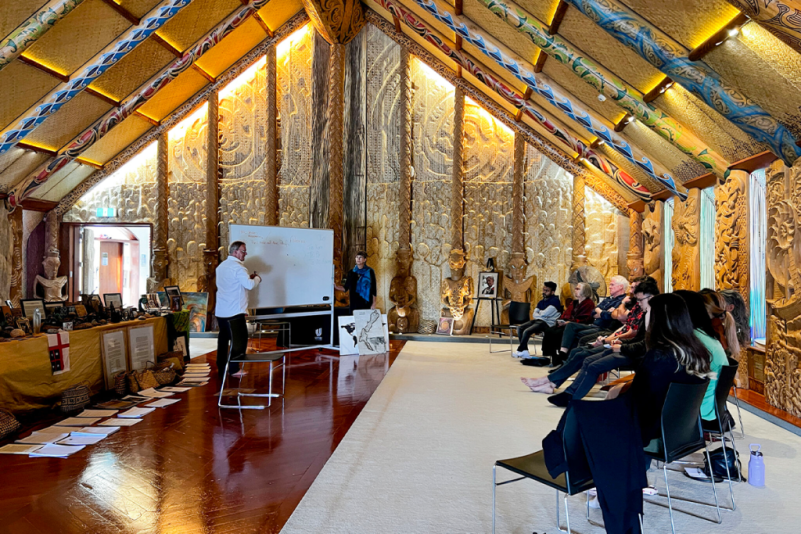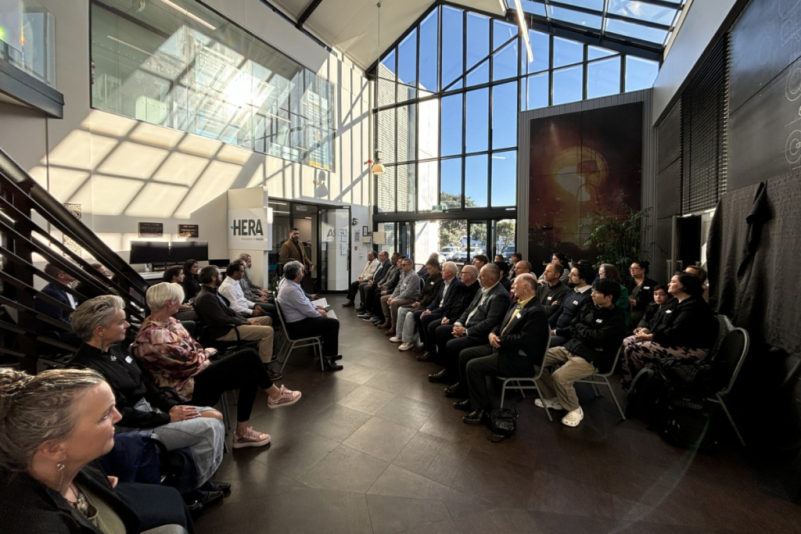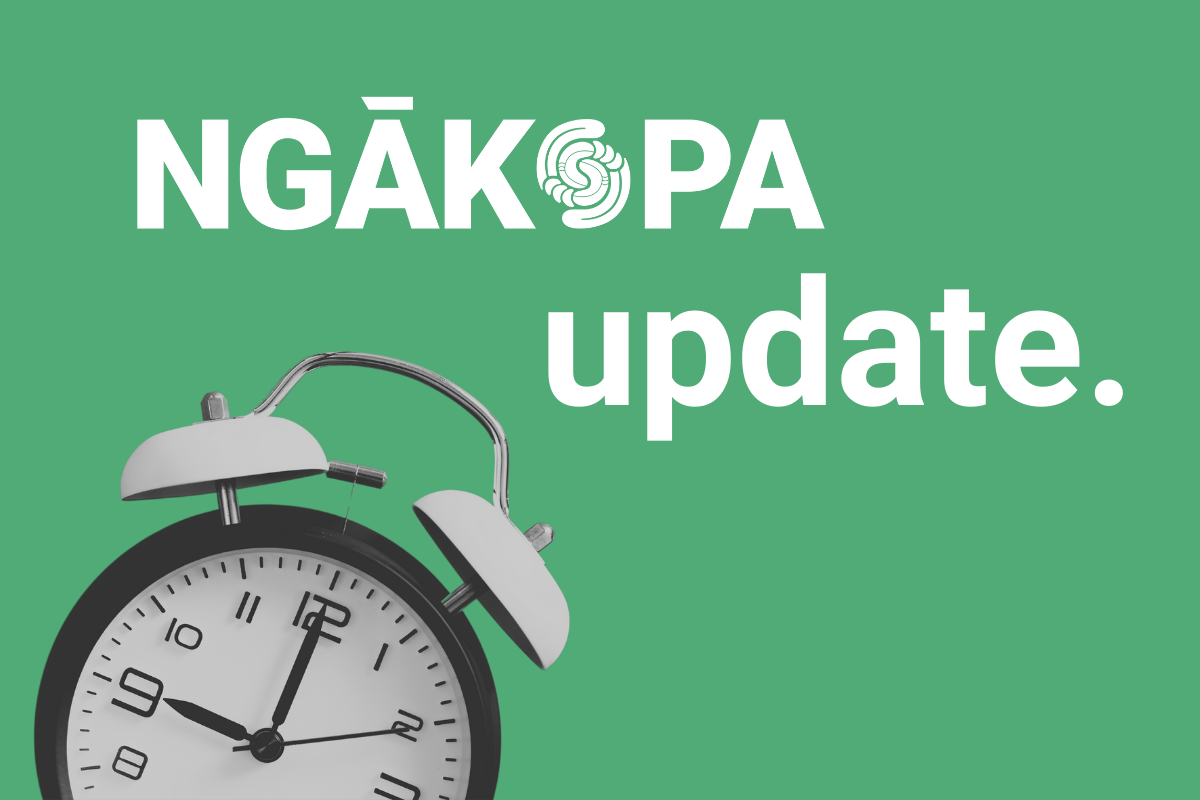Ngākopa Construction 4.0
A construction 4.0 – transformation of the Aotearoa NZ construction sector
Ngākopa Construction 4.0 is a HERA led research programme, funded through a 2022 Endeavour Fund of close to $10.3 million to support a four-year focus on transforming Aotearoa New Zealand’s construction sector.
We are a rōpū – a collective of multi-disciplinary global expert researchers developing practical data-driven tools that embrace the complexity of construction . We champion the interface between sustainable systems, mātauranga Māori and Construction 4.0 into future-focused solutions.
Above all, we want our research outcomes to be ready for adoption and readily adoptable – so they make real impact, in real time.
Program name: Developing a Construction 4.0 transformation of Aotearoa New Zealand’s construction sector
Lead organisation: HERA
Funder: MBIE Endeavour Fund
Status: $10.3 million awarded (2022)
Project duration: 4 years (2023–2027)
Research themes: Iwa | 9
Focus: Transforming Aotearoa’s construction sector through data, collaboration, and complexity science.
Anticipated impact: A more connected, circular, and resilient construction ecosystem, data-driven decision-making tools to improve performance and sustainability, embedding indigenous knowledge in built environment innovation and supporting industry adoption of Construction 4.0 technologies
Ngā kaupapa rangahau
Research themes
Data connectivity and standardisation
Readily shared & connected data. Standardised data management.
This research will develop Aotearoa New Zealand’s first standardisation infrastructure to support:
- Vertical integration – connecting systems used by different participants across the construction process.
- Horizontal integration – linking the broader value chain and enabling collaboration across networks.
It’ll also develop Cyber-Physical Construction Systems (CPCS), where real-time field data (via digital twins) are connected to their physical counterparts to support smarter, data-informed decision-making.
The research will focus on three critical steps:
- Developing standardised protocols for data generation, capture, transmission, conditioning, and storage.
- Embedding a Māori perspective on knowledge sharing and system design.
- Building a data processing and design-support framework for sector adoption.
Data connectivity & standardisation rōpū

Data Connectivity & Standardisation Lead.
Head of Laboratory for Industry 4.0 Smart Manufacturing Systems, University of Auckland.

Senior Lecturer Mechanical and Mechatronics Engineering, University of Auckland.

PhD Candidate, Mechanical Engineering, University of Auckland.

PhD Candidate, ME in Construction, University of Auckland.
Circular design
Improved decision support. Optimisation of structural models.
This program is the engine room of the overall project. It aims to develop evidence-based decisions support tools that use Construction 4.0 data to enable optimised design – where performance, cost, and environmental impact are considered together.
At its cores is the hypothesis that optimisation requirements can be achieved through a structural synthesis system – one that minimises environmental and cost impacts by considering constraints on design, manufacturability, materials and structural performance.
The research will identify target areas for optimisation and develop the novel models to do so.
The research will focus on four critical steps:
- Developing material and design solution protocols.
- Identifying optimisation targets.
- Verifying design optimisation through case studies.
- Identifying the key data attributes needed for optimisation.
Circular design rōpū



PhD Candidate, Civil Engineering, University of Auckland.

PhD Candidate, Civil Engineering, University of Waikato.

PhD Candidate, University of Michigan USA.

PhD Candidate, University of Michigan USA.
Smart construction
Creating a platform for design and automation.
This research will develop a framework for:
- Objective, data-improved monitoring and performance assessment of structural systems using in-situ data and numerical models.
- Optimal instrumentation plans to maximise the information gain while minimising the monitoring and instrumentation cost.
The outcome will be a calibrated digital twin – a key component of the Cyber-Physical Construction System (CPCS) used to evaluate how well structural systems perform against design expectations. It will also help identify modelling errors and feed into the overarching data standardisation program theme.
The platform developed will be able to analyse planning across building product manufacturing and construction projects – creating real-time, optimised solutions for constructability based on actual system capacity and capability within the value chain.
This means building product manufacturers, suppliers, builders, contractors and subcontractors will be able to better plan for new projects, prioritise resources and shift business models in the construction sector to adopt new technologies more efficiently.
The research will focus on five critical steps:
- Investigating the intrinsic properties of ‘file-to-factory’ workflows and computational needs.
- Clarifying the design constraints related to manufacturing capability.
- Testing building product and project signatures to support data interoperability.
- Identifying common workflow pinch points from design to production and assembly.
- Developing a conceptual computational framework and guidelines.
Smart construction rōpū
Monitoring 4.0
As-built structure insights. Feedback loops for performance.
Integrating structural health monitoring into the entire design, construction, and maintenance cycle means that information obtained from this data can be used to enhance the design and construction processes for new builds.
Monitoring 4.0 can be used for direct measurement or indirect estimation of external loads, estimation of material properties, and the geometry – improving accuracy, efficiency, and resilience across the sector.
The research will focus on five critical steps:
- Developing a Monitoring 4.0 framework for digital twinning of steel and reinforced concrete buildings.
- Creating design and instrumentation plans for implementation on existing buildings.
- Executing the digital twinning of structural systems using measurements.
- Validating the implemented digital twin framework.
- Comparing as-built performance with design performance forecasts.
Monitoring 4.0 rōpū
Mātauranga Māori
A uniquely Māori framework. Indigenous knowledge.
This research addresses the knowledge gap between Construction 4.0 and Mātauranga Māori, creating new knowledge for Aotearoa and offering a global example of how Indigenous perspectives can shape sector transformation.
It presents a powerful opportunity to acknowledge and embed Māori knowledge systems — with their unique contributions to architecture, engineering, and construction — as part of a more holistic, culturally grounded future for the built environment.
The research will focus on four critical steps:
- Developing a Te Ao Māori framework grounded in Māori perspectives.
- Creating Māori concepts and tools aligned with Construction 4.0 principles.
- Exploring the challenges and opportunities of cross-cultural collaboration.
- Embedding these frameworks across the research themes to support sector adoption.
Mātauranga Māori rōpū
Technology transfer
Co-creation in innovation ecosystems.
This research will reimagine how innovation is shared and scaled across Aotearoa’s construction sector — moving away from traditional linear models toward a co-created, partnership-based approach to technology transfer.
It explores the organisational, sectoral, and policy-specific factors that influence how knowledge flows — and aims to support a smoother, more inclusive transition to Construction 4.0 technologies.By investigating governance, industry, and community perspectives, the research will identify models that support real-world implementation, informed by international best practice and tested using action research.
The research will focus on three critical steps:
- Creating a partnership-based approach to technology transfer.
- Creating a data collection mechanism to capture real-time and historic data.
- Analysing the data and refining the model for continuous improvement.
Technology transfer rōpū
Sustainable futures
Whole of life approach. Life cycle analysis.
This research focuses on creating construction solutions that stay within our carbon budgets – aligned with the 1.5°C global climate target.
Using and extending existing emissions datasets (e.g. BRANZ CO₂NSTRUCT, ecoinvent), the research will calculate the whole-of-life carbon footprint of prefabricated and modular building approaches developed in RP1, RP2, and RP3. These will then be compared with conventional methods to assess their performance.
The goal is to embed climate-conscious design at every stage of the building process – from design and construction, to monitoring and adaptation.
The research will focus on four critical steps:
- Building on existing research on downscaling planetary boundaries.
- Developing methods for environmental limits-based carbon targets.
- Conducting climate change analysis (based on life cycle assessment) to compare Construction 4.0 alternatives.
- Integrating carbon footprint data into tools for use across design, construction and monitoring stages.
Sustainable futures rōpū
Emerging technologies
Flow of data. The right technology for transformation.
This research explores how cutting-edge AI and digital technologies, often developed outside the construction sector, can be applied to meet the complex, data-rich demands of Construction 4.0.
By building on tools used in other industries, this theme identifies and adapts interoperable AI solutions to support key areas of the programme – including circular design, smart construction, and Monitoring 4.0. A selection of evolving techniques will be selected and further developed to match the project’s needs – the goal being to ensure these advanced tools not only work technically but are aligned with the real-world needs of Aotearoa New Zealand’s construction sector.
The research will focus on four critical steps:
- Identifying emerging technologies relevant to Construction 4.0.
- Researching and refining these technologies to support circular design, smart construction, and monitoring.
- Documenting refinement processes to enable future adoption.
- Developing software methodologies that translate project needs into tailored, implementable solutions and software.
Emerging technologies rōpū
Ō mātou kaiārahi rangahau
Our research leads
Rōpū tohutohu ahumahi
Industry advisory group

Dave Anderson
Technical Director,
John Jones Steel

David Dowdell
Ngākopa Construction 4.0 Kairangahau – Sustainable Future
Principal Scientist,
BRANZ

Hilary West-Reeve
Executive Director – Chief Sustainability Officer,
Phoenix MetalMan Recycling

Saul Roberts
Waikato-Tainui, Te Waiohua (Ngāti Te Ata, Ngāti Te Rori)
IAG Co-Chair
Ngākopa Construction 4.0 Kairangahau – Mātauranga Māori
Pou Tātaki,
TOA Architects
Ngā karahipi
Scholarship opportunities
Nothing just yet…
but keep in touch!
Ngākopa Construction 4.0 is always looking for ways to tautoko the next generation of thinkers, doers, and disruptors in the construction space. If you’re keen to be notified when opportunities open up, join HERA’s student membership today to get notified!
-

Integrating mātauranga Māori into Construction 4.0
Imagine a construction sector guided not only by technology but knowledge uniquely connected to the rich heritage of Aotearoa.
-

Pioneering change – HERA launches two new kaupapa Māori initiatives
In a vibrant celebration of culture, innovation, and community, HERA proudly launched two kaupapa Māori projects – the Tohu App and Ngākopa.
-

Update: Endeavour research in Construction 4.0
The Construction 4.0 team wānanga and inaugural meeting of the Industry Advisory Group report.

















































